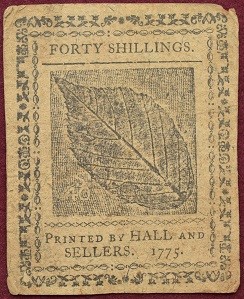
PREV ARTICLE
NEXT ARTICLE
FULL ISSUE
LIBRARY OF CONGRESS EARLY AMERICAN PAPER MONEYIn his Coin World paper money column December 27, 2019, Arthur L. Friedberg pointed out a recent blog post by Anastasia Binkowski of the Rare Book and Special Collections section of the Library of Congress discussing the library's Early American Paper Money Collection, part of which is currently on exhibit at the library. Here's an excerpt from her article. -Editor
The earliest paper money authorized by a government in the Western world was issued here in America, in the Massachusetts Bay Colony, in 1690. The earliest bill in The Early American Paper Money Collection was printed in 1746 for the Delaware colony by a name that may be familiar: Benjamin Franklin. Except for this early bill, the paper money printed by Franklin in the Library's collection is also attributed to his business partner David Hall. When Franklin eventually left the business to go abroad, Hall continued printing money with William Sellers. Franklin, Hall, and Sellers printed paper money out of the same shop for Pennsylvania, Delaware, Maryland, and New Jersey, as well as the Continental Congress. If you look at the back of many bills in the collection you will see “Philadelphia: Printed by Hall and Sellers.” Near those names you'll also see a detailed image of a leaf. This leaf isn't just a design element, it's an anti-counterfeiting tactic invented by Benjamin Franklin. We know now, based on continued study and a surviving block for printing, discovered by the Delaware County Institute of Science and explained by James Green in the 2013 Annual Report of the Library Company of Philadelphia (p25–28), that it actually involved double-casting: creating a plaster mold of a leaf and pouring type metal into the impression. By casting first in plaster and then in metal, the resulting metal piece would have the same raised veins and texture of the original leaf and could be nailed to wood to make it the same height as the rest of Franklin's type. The details of this image would be incredibly challenging to copy by hand-engraving and the block itself would be impossible to duplicate without the exact same leaf and the knowledge of how to create both strong enough plaster and the right metal alloy. Despite all this, counterfeiters would ultimately devise a way, by transfer and tracing, to reproduce the look of these nature prints without having to cast anything.
To read the complete blog article, see:
To read the Coin World article, see:
THE BOOK BAZARREWayne Homren, Editor The Numismatic Bibliomania Society is a non-profit organization promoting numismatic literature. See our web site at coinbooks.org. To submit items for publication in The E-Sylum, write to the Editor at this address: whomren@gmail.com To subscribe go to: https://my.binhost.com/lists/listinfo/esylum All Rights Reserved. NBS Home Page Contact the NBS webmaster 
|

